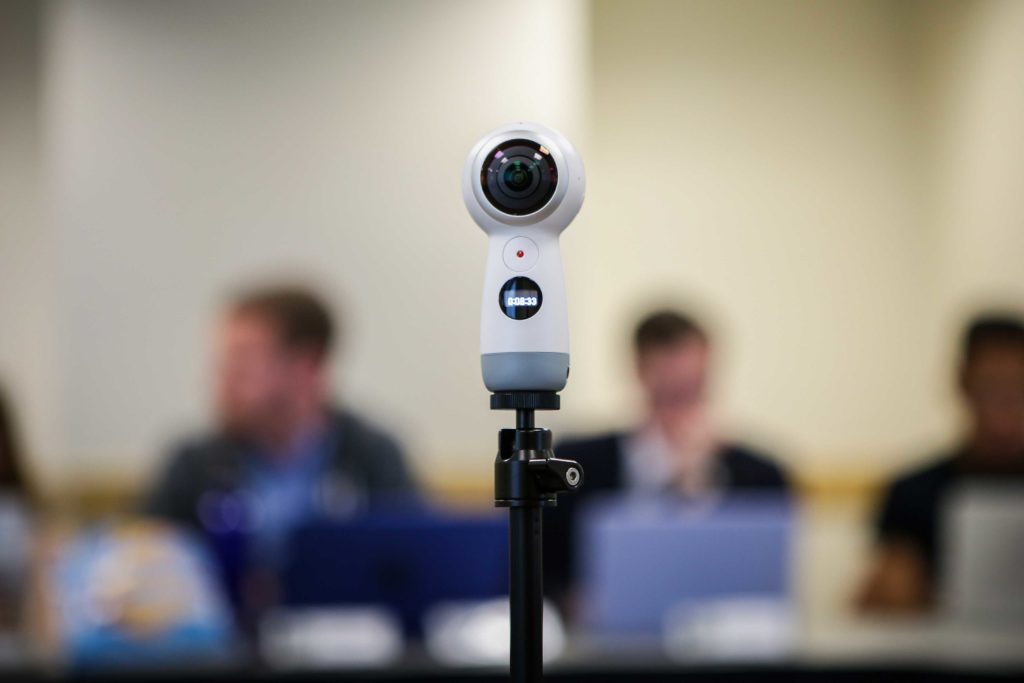When the Student Association met Wednesday, about 200 students watched the meeting through a computer screen – a number much higher than the usual in-person attendance.
The meeting, filmed by a 360-degree camera, livestreamed a fish-eye view of the senate meeting to the SA’s Facebook page, a practice the group began earlier this month. Leaders said the livestream is part of a broader SA goal to boost its online presence to be more accessible to the student body at large.
James Harnett, the SA’s director of digital policy and innovation, said increasing the SA’s online presence makes the body more transparent because students can stay up to date about the initiatives they are working on and virtually submit feedback.
Harnett spearheaded the remodel of an online petitioning platform last month for students to raise campus issues to the SA and led the effort to livestream senate meetings. He also oversaw the relaunch of the SA website last summer, adding tabs to include full copies of legislation and meeting minutes for the first time.
“We want to engage more students in the work that we’re doing,” he said. “We also want to elicit more feedback and more ideas from the other 25,000 students because we can’t create all the good ideas.”
[gwh_image id=”1050021″ credit=”Hadley Chittum | Hatchet Photographer” align=”none” size=”embedded-img”]James Harnett, the SA’s director of digital policy and innovation, said increasing the SA’s online presence makes the body more transparent because students can stay up to date about the initiatives they are working on and virtually submit feedback.[/gwh_image]
Issues related to audio and video have surfaced with the use of the 360-degree camera in the last couple of meetings, but Harnett said SA leaders recently invested in higher quality, industry-standard technologies – including a professional camera – to ensure that students can view senate meetings online without difficulties.
He declined to say how much the camera cost, but the model runs for about $300 on online outlets.
“The ability to go back and actually feel the emotion of a moment or what was happening at a meeting just beyond the headlines, I think is really an important way to engage with students and was something we realized we could benefit from,” he said.
The first livestreamed meeting was held Feb. 5 when senators debated a highly anticipated resolution on campus racism, coined the “Alpha Phi Bigotry Act,” after a member of the sorority posted a racist Snapchat. The livestream, which was restarted five times due to technical difficulties, peaked at roughly 3,200 simultaneous views.
Harnett added that going forward, he hopes to add more detail to the SA website about what initiatives have been worked on, who was involved in the creation of the initiatives and what ways those projects have succeeded and failed. Currently, the website’s initiatives page lists a few of the SA’s most high-profile projects of the year, including a paper-saving campaign and reform to student elections.
The SA has long faced criticism for being out of touch with the student body. The senate also passed a bill this month requiring senators to hold office hours in efforts to increase accountability.
SA Executive Vice President Sydney Nelson said the livestreams increase the body’s accessibility – especially for students who don’t spend much time on campus – because students can “watch their senators at work.”
“I think it’s important to recognize that the Student Association represents not only the undergraduate students who live on campus, but undergraduates who live off campus, who still live at home, who are commuters and the entire graduate population as well,” Nelson said.
The move online has also extended to internal senate policies and the Joint Elections Commission – the body that oversees SA elections. On Friday, the JEC moved to allow online and off-campus students who live far away from Foggy Bottom to collect signatures needed to run for an SA spot online.
SA representatives are set to debate a bill early next month allowing online or off-campus senators to virtually participate in SA meetings and vote on legislation electronically starting next academic year.
Sen. Alvin Lam, SEAS-G and the sponsor of the bill, said allowing online and off-campus students to virtually participate in senate meetings could inspire students who study online or at the Virginia Science and Technology Campus – who likely never would have run for the SA – to get involved.
“If we can bring those students to the SA, I think it would give us a lot of good opportunities to solve whatever academic problems or give us more ideas on what should we do to make our student life better,” he said.
The bill also mandates that all SA meetings be livestreamed and that a recording of the meeting be posted on social media or the SA website prior to the next meeting.
Sen. Katie Perroots, ESIA-G, who co-sponsored the bill, said online students “don’t have enough of a presence on campus” and the bill allows them to have a larger voice in campus decisions.
“We’re in a digital age already,” she said. “Almost everything can be done online – you can learn online, you can meet with people online and communication is just as effective online.”
Rebecca Leppert contributed reporting.





